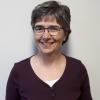After more than 40 years as a nurse, Lily Hiebert Rempel was starting to ease into retirement. That is when COVID-19 hit, and the health-care system needed more nurses, not fewer. She was not prepared to go into full-time critical care nursing but, with her public-health experience, she did have much to offer.
At the beginning of the pandemic, she was working part-time for Mennonite Central Committee (MCC) as a liaison for Low German-speaking Mennonites, connecting with their health units and service providers. Prior to that, she coordinated MCC’s Low German program.
A call from her professional nurses association for COVID-19 surge public-health nurses in northern Ontario caught her attention.
Unfortunately, a cycling accident in April 2020, that resulted in a concussion, put a halt to the idea, but only for a while. The idea kept on coming back and, when her concussion symptoms eased, she applied to Indigenous Services Canada. She went through an interview process and online learning for nurses, in preparation for working as a public-health nurse in the Sandy Lake First Nation, a community of 3,500 people, northeast of Kenora, Ont.
Travelling to the community meant a 14-day quarantine before leaving, and then taking a charter flight from Toronto to Thunder Bay and then to Sioux Lookout with other health-care providers bound for northern communities.
In Sandy Lake, basic health care is provided by a team of around a dozen nurses working out of a nurses station. Two work full time. Most others came in for four-week rotations during the pandemic. There is no full-time doctor or dentist in the community, so people travel to Thunder Bay, Winnipeg or Sioux Lookout for other medical services. Hiebert Rempel says it is challenging for people in the community to develop a sense of connection with their health-care provider.
She completed three, four-week rotations in Sandy Lake, one in June 2020, then one from mid-July to mid-August 2020, and most recently this March. She said she felt like a new nurse again, with so much to learn.
She provided community education about COVID-19 transmission and followed up with people returning to the community from medical appointments in other cities. She also did some prenatal and postpartum public-health work, making a few home visits to support mothers and babies.
She was struck by the limited services in the community and the crowded housing, to the point that people had to take turns sleeping. There were no paved roads, and food was expensive. On top of that, the tap water was unsafe, so drinking water was supplied. Work on a water treatment plant is underway.
A new nurses station was also under construction, so the residence for it was used as an isolation centre. People returning from the city needed space to quarantine for two weeks.
The high school was also used for quarantine, giving each family who needed the space a classroom to stay in. A structure was also built next to the nurses station that served as an assessment centre for testing. With these protocols in place, the nurses were able to contain the few cases of COVID-19 that did occur. By this March, more than 90 percent of the adults were vaccinated.
Hiebert Rempel stayed with other nurses, many of them much younger than her, in the apartments attached to the nurses station. She said they had a wonderful relationship and did some hiking and canoeing together.
She was very aware of being a white nurse from outside the community. One experience highlighted the need for cultural sensitivity. On her second stint at the nursing station, a man came into the office, closed the door and told her why he was not glad that she was back. He explained that, during her previous visit, she had gotten into his personal space, which triggered a flashback from his residential-school experience. She was grateful for his strength and courage in letting her know about the incident that had inadvertently caused discomfort.
That incident reinforced for her that non-Indigenous people need to be well informed about the trauma of the residential school experience and the policies of the Indian Act. “We are learning more, and we can begin to speak up more,” she said. “We cannot remain silent.”
She said she is “deeply grateful” for the opportunity to work in the Sandy Lake community, having found the experience “life-giving” and providing a chance to experience something new. As someone with freedom and flexibility in her life right now, she saw this opportunity as a responsibility, even an obligation to do what she could.
She is also helping with vaccination clinics at Six Nations at Ohsweken, Ont. She plans to return to Sandy Lake for another rotation.
Do you have a story idea about Mennonites in Eastern Canada? Send it to Janet Bauman at ec@canadianmennonite.org.

Lily Hiebert Rempel inside the nurses station at Sandy Lake First Nation in northwestern Ontario, where she worked as a public-health nurse on three different occasions during the pandemic. (Photo courtesy of Lily Hiebert Rempel)

The nurses station at Sandy Lake First Nation, where Lily Hiebert Rempel worked during her three, four-week rotations as a public health nurse in the community. (Photo courtesy of Lily Hiebert Rempel)





Add new comment
Canadian Mennonite invites comments and encourages constructive discussion about our content. Actual full names (first and last) are required. Comments are moderated and may be edited. They will not appear online until approved and will be posted during business hours. Some comments may be reproduced in print.